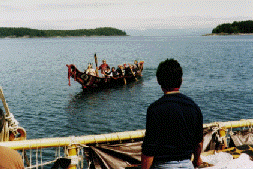|
Port Hardy, British Columbia / June 17, 1995 Photo Below: Crew Member Aaron Young Watches a Kwaguitl Canoe Approach Hawai'iloa
The crew of the canoe is heading to Juneau to thank Sealaska, a corporation owned by the Tlingit, Haida, and Tsimshian tribes, for the gift of spruce logs from which the twin hulls of "Hawai'iloa" are carved. Protocol requires that the canoe stop at communities of native peoples whose traditional territorial waters the canoe enters. A cedar-bark canoe met "Hawai'iloa" off Fort Rupert, a Kwagiutl community about 10 miles from the town of Port Hardy. A delegation of the crew, led by captain and navigator Bruce Blankenfeld, went ashore for a formal greeting ceremony. That evening the crew returned to the Big House at Fort Rupert for a potlatch--a traditional ceremony that includes eating, drumming, singing, dancing, and gift-giving. Inside the Big House a cedar fire blazed for the presentation of dances, a cycle called Hamatsa, in which a young man who has gone wild after seeking a vision for his life in the forest is brought back to the tribe and made tame again through the chanting of the women. The dance cycle features large wooden masks, elaborately carved and painted, which transform some of the dancers into the supernatural beings that the initiate encounters in the spiritual realms. "Hawai'iloa" has been slowly making its way north from Seattle, where it arrived on May 19, along with Hokule'a. While travelling from Seattle to Vancouver, the two double-hulled canoes were greeted and hosted by native tribes (the Coast SalishÑLummi, Suquamish, and Musqueum), dignitaries, and Hawaiians living in the Northwest. The canoes separated in Vancouver on June 12, with "Hawai'iloa" heading to Alaska, and Hokule'a south to Oregon and California. "Hawai'iloa" is being escorted and towed by "Marc Alan," a 58-foot seine boat owned by Hutch Hunt, a Kwagiutl fisherman who lives in Fort Rupert. Hunt, who has been a visitor to Hawai'i for the past 25 years, knows the dangerous straits and narrow passages between the dozens of forested islands along the coast. The art of navigating in these waters is based on knowledge of tidal shifts of 15-20 feet, 15 knot currents, and swiftly changing weather. Drifting logs, hidden rocks, and heavy boat traffic are other hazards. Although the summer solstice is approaching, the weather has been chilly, down to the 40's, particularly on the water. The northwest wind can make it even colder, forcing crew members into layered cold-weather gear as they stand watch on the open deck of the canoe. But the journey has been full of rewards for the crew in making new friends, exchanging cultural information, and lending support to the revivals of native cutlures going on along the coast. Despite the differences in climate and environment, the Hawaiian crew has found much in common with the native peoples of British Columbia--not just canoe-building traditions, but also the values of hospitality and sharing, reverence for ancestors and family, and caring for the environment. At Alert Bay, the stop before Port Hardy, the "Hawai'iloa" crew attended a celebration of a victory of the Nimpkish tribe--a negotiated agreement with the provincial government to move a road that was built over an ancestral burial site. Two totems pole--Halibut Man and Eagle--were unveiled to commemorate the victory. After an afternoon potlatch and a Salmon Princess and Prince competition that honored a young boy and girl for their knowledge of the native language and culture, chief Bill Kramer, director of the U'Mista Cultural Center, told the "Hawai'iloa" crew the story of how the Center was created from a struggle to bring back to the community sacred masks and coppers that had been confiscated by the govemment and placed in a museum in Montreal after potlatches had been outlawed. Moved by the strength of cultural revival among the Nimpkish and in show of solidarity, Captain Blankefeld of "Hawai'iloa" presented the Cultural Center with one of the paddles that made the journey with the canoe to Tahiti, Nukuhiva, and back to Hawai'i. Despite these victories the struggle between traditional and modern uses of the land continues in the Northwest as in Hawai'i, with the traditional uses losing ground to commercial interests. Chief West, who brought his cedar canoe out to greet "Hawai'iloa" at Alert Bay and was invited aboard "Hawai'iloa" for the trip to Port Hardy, told the crew the story of how the the cod and salmon had disappeared from the waters around Alert Bay, the traditional fishing ground of the Nimpkish. He said the cod had been overfished and the salmon spawning streams had been ruined by logging. Crew for the First Leg / Seattle to Vancouver
Crew for the second leg / Vancouver to Ketchikan
|

 The voyaging canoe "Hawai'iloa" arrived in Port Hardy, Vancouver Island, British Columbia on Friday, June 16, for a three-day stay. The canoe will be heading north to Bella Bella on Sunday, June 18, then continue on its 1,200 mile journey up the Northwest Coast to Juneau, Alaska, with a dozen stops in between.
The voyaging canoe "Hawai'iloa" arrived in Port Hardy, Vancouver Island, British Columbia on Friday, June 16, for a three-day stay. The canoe will be heading north to Bella Bella on Sunday, June 18, then continue on its 1,200 mile journey up the Northwest Coast to Juneau, Alaska, with a dozen stops in between.